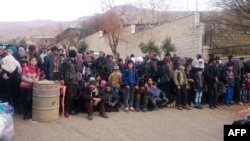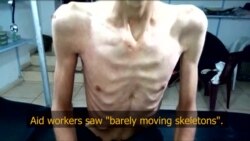Humanitarian workers say the plight of starving people in the Syrian town of Madaya is heartbreaking and the worst they have witnessed during the country's nearly five-year-long civil war.
"There is no comparison in what we saw in Madaya," Sajjad Malik, the United Nations refugee agency's chief in Damascus, told journalists in Geneva Tuesday, a day after the U.N. delivered aid to the embattled town of 42,000 people surrounded by forces loyal to Syrian President Bashar al-Assad.
Malik said there were "credible reports" of people starving to death in Madaya.
"There are people in Madaya, but no life," he said. "What we saw in Madaya should not happen in this century."
“We saw a people that are desperate; a people that are cold; a people that are hungry; a people that have almost lost hope that the world cares about their plight,” Yacoub el Hillo, the U.N.'s resident and humanitarian coordinator in Syria, told reporters at the U.N. in New York via phone from Damascus.
El Hillo said the people told him they want the international community to do more to have sieges lifted wherever they are being imposed in Syria.
“All parties to this conflict are exercising it [sieges] and it must stop,” he added.
The United Nations says 400,000 Syrians live in areas besieged by the government, rebels or armed groups. Millions more live in areas classified as ‘hard-to-reach’ for aid workers.
'Barely moving skeletons'
Syria's ambassador to the U.N., Bashar Jaafari, told reporters Monday there is "no starvation in Madaya," rebuffing a report from the international medical charity Doctors Without Borders that 28 people in the town had starved to death.
El Hillo refuted that, saying he and his team saw “severely malnourished” people there who were “extremely thin, as skeletons, that are now barely moving.”
Elizabeth Hoff, a World Health Organization official who accompanied the aid convoy Monday, told the Reuters news agency, "I am really alarmed. People gathered in the market place. You could see many were malnourished, starving. They were skinny, tired, severely distressed. There was no smile on anybody's face. It is not what you want to see when you arrive with a convoy. The children I talked to said they had no strength to play."
The WHO brought in nearly eight tons of medicine, including trauma kits for wounds, in the convoy, while the U.N. refugee agency trucked in food. At the same time, WHO delivered nearly four tons of medical supplies to Foua and Kafraya, two villages in Idlib province surrounded by anti-government rebels.
Beyond the initial convoys agreed to by Damascus, the WHO is asking for permission to send mobile clinics and medical teams into Madaya to determine the extent of the malnutrition there and to be able to evacuate those in the direst of circumstances.
"It's really heartbreaking to see the situation of the people," said Pawel Krzysiek of the International Committee of the Red Cross. "A while ago I was just approached by a little girl and her first question was did you bring food... we are really hungry."
U.N. humanitarian and development agencies appealed Tuesday for $7.73 billion in new funding for 2016 to help 22.5 million people in Syria and across the region.
The aid agencies say the funding is needed to help 4.7 million refugees expected to flood into in neighboring countries from the conflict zone by the end of 2016 and support another 13.5 million displaced and conflict-affected people inside Syria itself.
The Syria appeals are part of the wider 2016 humanitarian appeal, asking for $20.1 billion to reach 87 million people in various crises zones around the world.












